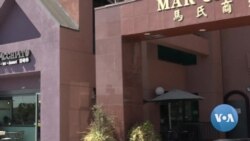ເມື່ອປ້າຍທີ່ຂຽນເປັນພາສາ ຈີນ ເລີ່ມປາກົດຂຶ້ນ, ພ້ອມກັບຮ້ານຂາຍເຄື່ອງຍ່ອຍຂອງ ເກົາຫຼີ ແລະ ຍີ່ປຸ່ນ ແລະ ຮ້ານອາຫານທີ່ມີອາຫານລົດຊາດ ຈາກເກືອບທົ່ວທຸກປະເທດຂອງທະວີບ ເອເຊຍ ນັ້ນ, ມັນເປັນສັນຍານທີ່ວ່າທ່ານໄດ້ເຂົ້າໄປໃນພາກພື້ນ ແຊນ
ແກບຣີແອລ ວາເລ (San Gabriel Valley) ແລ້ວ.
ສຳລັບບາງຄົນ, ມັນແມ່ນເຂດທີ່ຢູ່ອາໄສຂອງນະຄອນ ລອສ ແອນເຈີລິສ. ສຳລັບຄົນອື່ນໆ, ຂົງເຂດ ເອເຊຍ ນັ້ນແມ່ນບ່ອນທີ່ສະດວກສະບາຍຄືກັບຢູ່ບ້ານ.
ພາກພື້ນ ແຊນ ແກບຣີແອລ ວາເລ, ເຊິ່ງຄົນໃນທ້ອງຖິ່ນເອີ້ນວ່າ SDV ນັ້ນ, ມີຄວາມຍາວ 36 ກິໂລແມັດ ທາງພາກຕາເວັນອອກ ຂອງຕົວເມືອງນະຄອນ ລອສ ແອນເຈີລິສ, ພ້ອມກັບຄົນເອເຊຍ ເກືອບເຄິ່ງລ້ານຄົນອາໄສຢູ່ທີ່ນັ້ນ. 9 ເມືອງທີ່ຢູ່ໃນບໍລິເວນດັ່ງກ່າວ ແມ່ນມີຄົນເອເຊຍອາໄສຢູ່ເປັນສ່ວນຫຼາຍ.
ມັນລວມມີເມືອງ ວາລນັດ (Walnut), ບ່ອນທີ່ຄອບຄົວຂອງທ່ານ ໄມຄ໌ ໂຈ ໄດ້ຍ້າຍມາອາໄສຢູ່ໃນປີ 1989 ເວລາທີ່ເຂົາເຈົ້າໄດ້ຍົກຍ້າຍມາຈາກ ໄຕ້ຫວັນ. ເມືອງ ໄຕ້ຫວັນ ແມ່ນໄດ້ກໍ່ຕັ້ງຊຸມຊົນຄົນ ຈີນ ຂຶ້ນມາແລ້ວໃນເວລານັ້ນ.
ທ່ານ ໂຈ, ຜູ້ທີ່ມີອາຍຸ 5 ປີຕອນທີ່ຄອບຄົວຂອງລາວໄດ້ເດີນທາງມາຮອດ ສະຫະລັດ, ໄດ້ກ່າວວ່າ “ພໍ່ແມ່ຂອງຂ້າພະເຈົ້າ, ເພິ່ນເວົ້າພາສາອັງກິດບໍ່ໄດ້ໃນເວລານັ້ນ, ສະນັ້ນມັນຈຶ່ງງ່າຍສຳລັບພວກເພິ່ນທີ່ຈະໄປໄສມາໄສ. ມັນໃກ້ກັບບ່ອນຂາຍເຄື່ອງທັງໝົດຫຼາຍ. ມັນໃກ້ກັບຮ້ານຂາຍເຄື່ອງຍ່ອຍຫຼາຍ. ມັນເຮັດໃຫ້ການປັບຕົວເຂົ້າກັບທີ່ນັ້ນງ່າຍຫຼາຍ.”
ອີງຕາມລາຍງານການພະຍາກອນເສດຖະກິດ ແລະ ການສຳຫຼວດພາກພື້ນຂອງ ແຊນ ແກບຣີແອລ ວາເລ ປີ 2019 ນັ້ນ, ພາກພື້ນດັ່ງກ່າວ ມີປະຊາກອນຊົນເຜົ່າ ຈີນ ຂະໜາດໃຫຍ່ອາໄສຢູ່ທີ່ນັ້ນ ທີ່ໄດ້ເລີ່ມຂຶ້ນໃນຊຸມປີ 1970, ດ້ວຍການຫຼັ່ງໄຫຼເຂົ້າມາຂອງຜູ້ຍົກຍ້າຍຖິ່ນຖານຈາກ ໄຕ້ຫວັນ.
ທ່ານ ໂຈ ຕອນນີ້ແມ່ນພະນັກງານຂາຍອະສັງຫາລິມະຊັບ ທີ່ມີລູກຄ້າ 80 ເປີເຊັນເປັນຄົນເອເຊຍ, ເຊິ່ງເຄິ່ງນຶ່ງແມ່ນຄົນ ຈີນ. ການທີ່ສາມາດເວົ້າພາສາ ຈີນກາງ ແລະ ອັງກິດ ໄດ້ຢ່າງລ່ຽນໄຫຼນັ້ນ, ທ່ານ ໂຈ ໄດ້ປະສົບຄວາມສຳເລັດຢ່າງຫຼວງຫຼາຍໃນການຂາຍອະສັງຫາລິມະຊັບ ທີ່ຕອນນີ້ ລາວໄດ້ເປັນຜູ້ນຳໜ້າຂອງທີມພະນັກງານທີ່ສາມາດເວົ້າໄດ້ຫຼາຍພາສາ, ລວມມີນາງ ຣັອກເຊນ ເຊັງ, ຜູ້ທີ່ໄດ້ຍົກຍ້າຍຖິ່ນຖານມາ ສະຫະລັດ ຈາກ ຈີນ ໃນປີ 2005 ເພື່ອຮຽນຕໍ່ລະດັບສູງ ແລະ ໄດ້ຢູ່ເລີຍ.
ນາງ ເຊັງ ໄດ້ກ່າວວ່າ “ລູກຄ້າສ່ວນຫຼາຍຂອງຂ້າພະເຈົ້າແມ່ນຄົນ ຈີນ ທີ່ເວົ້າພາກສາ ຈີນ ກາງ. ແຕ່ເຂົາເຈົ້າໄດ້ອາໄສຢູ່ທີ່ນີ້ ແລະ ກໍເຮັດວຽກຢູ່ທີ່ນີ້, ຫຼື ຮຽນຢູ່ທີ່ນີ້. ຫຼືເຂົາເຈົ້າມາ ສະຫະລັດ ເພື່ອລົງທຶນອີກເທົ່ານັ້ນ, ເພື່ອຊື້ຊັບສິນການລົງທຶນ. ແຕ່ເຂົາເຈົ້າຍັງກັບໄປ ຈີນ ແລະ ອາໄສຢູ່ທີ່ນັ້ນຢູ່.”
ໃນໄລຍະ 10 ຫາ 15 ປີທີ່ຜ່ານມາ, ທ່ານ ໂຈ ໄດ້ກ່າວວ່າປະຊາຊົນຈາກ ຈີນ ແຜ່ນດິນໃຫຍ່ ໄດ້ກາຍເປັນຜູ້ຍົກຍ້າຍຖິ່ນຖານໃໝ່ຂອງພາກພື້ນ ແຊນ ແກບຣີແອລ ວາເລ.
When billboards in Chinese start appearing, along with Korean and Japanese grocery stores and restaurants that span tastes from almost all of Asia, they are signs that you have entered the San Gabriel Valley.
For some people, it is a bedroom community of Los Angeles. For others, the Asian enclave is a home away from home.
Known to the locals as the "SGV," San Gabriel Valley spans 36 kilometers east of downtown Los Angeles, with close to half a million Asians living there. Nine cities in the area are majority-Asian. [[ https://sgvpartnership.org/resources/Documents/2019_Econ_Summit_final_w_appendices.pdf ]]
They include the city of Walnut, where Mike Chou's family settled in 1989 when they immigrated from Taiwan. Walnut already had an established Chinese community at the time.
"My parents, they didn't speak English at the time, so it's made it easier for them to kind of get around," said Chou, who was 5 when his family arrived in the United States. "It's so close to all the shopping. It's so close to the (Chinese) grocery stores. It made fitting in there a lot easier."
According to the 2019 San Gabriel Valley Economic Forecast and Regional Overview Report, the SGV has a large ethnic Chinese population that started in the 1970s, with a flood of immigrants from Taiwan.
Chou is now a real estate agent with an 80% Asian clientele -- half of them Chinese. Speaking fluent Mandarin and English, Chou has been so successful in real estate that he now leads a multilingual team of agents, including Roxane Sheng, who immigrated to the United States from China in 2005 for graduate school and stayed.
"Most of my clients are Mandarin-speaking Chinese," Sheng said. "But they're either living here and work here, or study here. Or they come to United States just to reinvest, to buy investment property. But they still go back to China and live there."
In the past 10 to 15 years, Chou said people from mainland China have become the new immigrants to the SGV.





